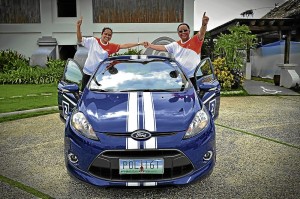
THIS odd pair, believe it or not, composed of Dino Directo of Manila Standard-Today and the author, broke the record, achieving a 23.66 km per liter fuel-efficiency mark.
Sounds ironic, doesn’t it? How can you scrimp on something so festive as a fiesta? How can this chic compact hatch from Ford named after celebrations of abundance and indulgence involve itself in such a down-to-earth concept as fuel economy?
Ford Motor Company Philippines’ best-selling model the Fiesta, just about to turn a year old this Oct. 15, sends a clear message to the motoring public: Frugal can be fun.
Participants to the Fiesta fuel economy challenge held Sept. 17 and 18 certainly got the message loud and clear.
Six teams, each composed of a driver and navigator, from the motoring media and Fiesta owners selected online, took on the challenge hurled by Ford Motor Company Philippines: Beat the recent Ford Fiesta fuel consumption record of 19 km/liter (achieved on a Fiesta 1.6L A/T Trend sedan, which ran 747 km on a single tank of fuel).
With representatives from the Automobile Association Philippines and the UP National Center for Transport Studies and Ford Motor Company Philippines supervising the proceedings, six Fiesta five-door models and a sedan left Ford Balintawak at 5:15 a.m. and reached Shell Magsingal, Ilocos Sur nearly 16 grueling hours and 573 km later. The moment of truth—when the gas tanks would be re-filled and measured—were witnessed with bated breath by Ford’s assistant vice president for communications Anika Salceda-Wycoco, the Brand on Demand team and Isa Suarez of Ogilvy Public Relations.

FOFI’S LUCKY COLOR The head-turning, blue and white-striped Ford Fiesta 1.6-liter—taking its time at the Subic-Clark-Tarlac Expressway
In the end, the previous record was soundly eclipsed by a new one—an astounding 23.66 km per liter, as registered by the team composed of this writer and Dino Directo of Manila Standard-Today, in a Fiesta Sport 1.6-liter five-door hatchback.
Multiple winner
At the outset, though, we were not favored to come out on top. Directo’s hefty build was already equivalent to the tandem of Top Gear Philippines’ Sharleen Banzon and Barbara Lorenzo. But Directo, a multiple winner of previous fuel economy runs organized by various manufacturers, had the science of thrifty driving down pat. His weight notwithstanding, his right foot was as light as a feather as he drove 383 km of the way. This writer, his partner, did remind him, though, “If we win, it’s your skills. If we lose, it’s your weight.”
Measures were taken by the supervising parties to ensure that the air-conditioning controls and fuel lids would not be tampered with. Marshals also guided the convoy, and enforced traffic rules. Although teams were allowed to pass each other, they were prohibited from overtaking the lead marshal or falling behind the sweeper marshal.
Maintaining the fuel-optimal speed of between 60 and 80 kph and the ideal RPM range of between 1,800 and 2,000 was, in some stretches, tedious and yawn-inducing, but demanded complete attention. Directo revealed that part of the secret to a good fuel mileage was to imagine that a chicken egg was tied to the accelerator and brake pedals, and your job would be not to break them. Easier said than done in our roads, with our kind of driving habits. We not only had to contend with road hazards such as pedestrians and tricycles and other animals crossing the roads, we also had to deal with strong cross winds and monsoon rains, flooded streets, road repairs, poor road visibility, the works. We might as well have destroyed thousands of eggs.
UP-NATIONAL Center for Transport Studies’ Sheila Flor Dominguez-Javier checks the odometer and crunches the numbers.
In the end, we were not the only ones who surpassed the 19 km/liter benchmark. The Top Gear team had a fuel mileage of 19.545 km/liter, while third placer Autoindustriya (Inigo Roces and Vince Pornelos) ended up with 19.253 km/liter.
The tandem of Carlo Tirona and Lorenzo Teodoro produced 19.177 km/liter. Rounding up the results were the Ron de los Reyes-Angel Rivero pair (18.829 km/liter) and Omar Gabrieles-Sherwin Go (18.297 km/liter).
While Directo puts it at a practical level, Japan’s National Institute for Environmental Studies of the Ministry of the Environment had shared to UP-NCTS’ Sheila Flor Dominguez-Javier the three forces acting on a moving vehicle when it runs: Acceleration resistance (Proportional to vehicle weight and acceleration), wind resistance (proportional to the square of vehicle speed), and rolling resistance (proportional to vehicle weight). From these forces, one can determine the kinetic energy needed to move a vehicle.
Moderate speed
It is evident that driving at moderate speed is the most effective way to save on kinetic energy consumption. Two crucial habits to achieve maximize fuel consumption are: Observing speed limits, maintaining constant speed, and; anticipating traffic flow, and releasing the accelerator early.
Just as an experiment, on my way back to Manila from Ilocos Norte, I violated these two key points (in short, I drove like most of us do, as someone in a hurry to go back home). After filling up, my fuel mileage was 9 km per liter.
And I certainly felt much more stressed out during the drive back.

